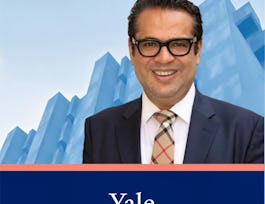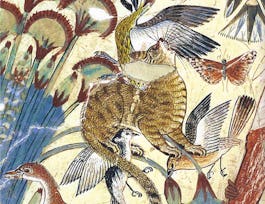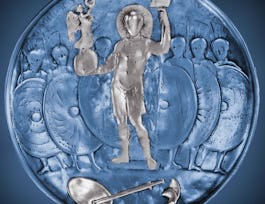An introduction to some of the most astonishing architectural monuments the world has ever known—Gothic cathedrals. We shall study the art, literature, intellectual life, economics, and new social arrangements that arose in the shadow of the cathedrals and that were such an important part of the revival of cities in the twelfth and thirteenth centuries. The goal of the course is a better appreciation of the High Middle Ages, a world that is still recognizably our own.


Age of Cathedrals
Taught in English
Some content may not be translated
35,746 already enrolled
(459 reviews)
Details to know

Add to your LinkedIn profile
4 quizzes
See how employees at top companies are mastering in-demand skills


Earn a career certificate
Add this credential to your LinkedIn profile, resume, or CV
Share it on social media and in your performance review

There are 9 modules in this course
An introduction to the history of Paris in the centuries of chaos following the death of Charlemagne in 814 and the building of the first Gothic cathedral at Saint-Denis, just north of Paris. The old abbey church, where the kings of France were buried, was inadequate, and so a new building project was undertaken by Abbot Suger, who financed the new building through efficient land management and the commercial Fair of Lendit along a trade route between northern and southern Europe.
What's included
7 videos1 reading
Here we encounter the portrait of Abbot Suger via his account of how and why he built Saint-Denis, what is portrayed on the West façade of the cathedral, and how the doctrine of God as light, encountered in a book which had come from Byzantium to the abbey centuries earlier, was translated into architectural form. We see some of the objects that are part of the treasury of Saint-Denis and discuss the Abbot’s notion of “anagogical uplift” as a way of moving—via stained glass—between the Old and New Testaments and from the material to the spiritual plane.
What's included
8 videos3 readings1 quiz1 peer review
Filling in the background of Romanesque churches that preceded Gothic buildings, we discuss the origins and engineering innovations of the new style of religious architecture. These include ribbed vaults, reinforced pillars, pointed arches, flying buttresses, and a modular system of bay construction; all of which permits the construction of higher and lighter, thinner walls filled with stained glass.
What's included
4 videos1 peer review
Moving to the heart of Paris, we explore the initial construction of Notre-Dame and the innovations that were undertaken almost as soon as the building began. We discuss the sculptural programs of Notre-Dame’s West façade, including the portal which depicts the life of Saint Anne, Christ’s grandmother, and Mary, his mother and the central portal of the Last Judgment. Along the south side, we discover the story of the stoning of Saint Stephen; and, along the North, the miracle of Theophilus and the Virgin. Moving inside the cathedral, we encounter the stunning rose windows of Notre-Dame.
What's included
10 videos3 readings1 quiz
Here we examine the cathedral in terms of surrounding intellectual and everyday life. A reading of Peter Abelard’s autobiography, The Story of my Misfortunes, testifies to the growth of the scholastic method in the context of the earliest university culture; and two verse comic tales, “The Crucified Priest” and “The Peekaboo Priest” introduce the new mentality of the inhabitant of towns with emphasis on cleverness, quick thinking, and timing along with an anti-clerical spirit.
What's included
5 videos3 readings1 peer review
In Module 6 we move West of Paris to the cathedral of Chartres where Gothic architecture hits its stride. We explore the history of Chartres, its unique and mysterious architectural features, and its miraculous relic—the Holy Tunic. We discuss the financing of Chartres as seen in the windows donated by merchant which depict the various urban trades alongside the sculpture of the West façade, the rose and lancet stained glass windows, and the secular Zodiac and Charlemagne windows, the latter of which is linked to important literary works of the period.
What's included
10 videos1 reading1 quiz
In Module 7 we examine in some detail The Song of Roland, portions of which are depicted in the stained glass of Chartres, and we explore the relationship of relics from the Middle East to cathedral building.
What's included
7 videos1 reading1 peer review
In Module 8 we explore Saint Louis’s building of the Sainte-Chapelle in Paris as a house of glass, a new Ark of the Covenant, to house the relics he had amassed. Using Jean de Joinville’s Life of Saint-Louis as our source, we encounter the Saint King’s life as a crusader, his death, canonization, and the miracles performed by his body on his way to sainthood.
What's included
12 videos1 reading1 quiz
By way of conclusion, we explore the history of Gothic cathedrals from the Middle Ages to the present.
What's included
1 video
Instructor

Offered by
Recommended if you're interested in History

Yale University

Ludwig-Maximilians-Universität München (LMU)

Sapienza University of Rome

University of Geneva
Why people choose Coursera for their career




Learner reviews
Showing 3 of 459
459 reviews
- 5 stars
78.69%
- 4 stars
16.30%
- 3 stars
3.47%
- 2 stars
0.65%
- 1 star
0.86%

Open new doors with Coursera Plus
Unlimited access to 7,000+ world-class courses, hands-on projects, and job-ready certificate programs - all included in your subscription
Advance your career with an online degree
Earn a degree from world-class universities - 100% online
Join over 3,400 global companies that choose Coursera for Business
Upskill your employees to excel in the digital economy
Frequently asked questions
Access to lectures and assignments depends on your type of enrollment. If you take a course in audit mode, you will be able to see most course materials for free. To access graded assignments and to earn a Certificate, you will need to purchase the Certificate experience, during or after your audit. If you don't see the audit option:
The course may not offer an audit option. You can try a Free Trial instead, or apply for Financial Aid.
The course may offer 'Full Course, No Certificate' instead. This option lets you see all course materials, submit required assessments, and get a final grade. This also means that you will not be able to purchase a Certificate experience.
When you purchase a Certificate you get access to all course materials, including graded assignments. Upon completing the course, your electronic Certificate will be added to your Accomplishments page - from there, you can print your Certificate or add it to your LinkedIn profile. If you only want to read and view the course content, you can audit the course for free.
You will be eligible for a full refund until two weeks after your payment date, or (for courses that have just launched) until two weeks after the first session of the course begins, whichever is later. You cannot receive a refund once you’ve earned a Course Certificate, even if you complete the course within the two-week refund period. See our full refund policy.


